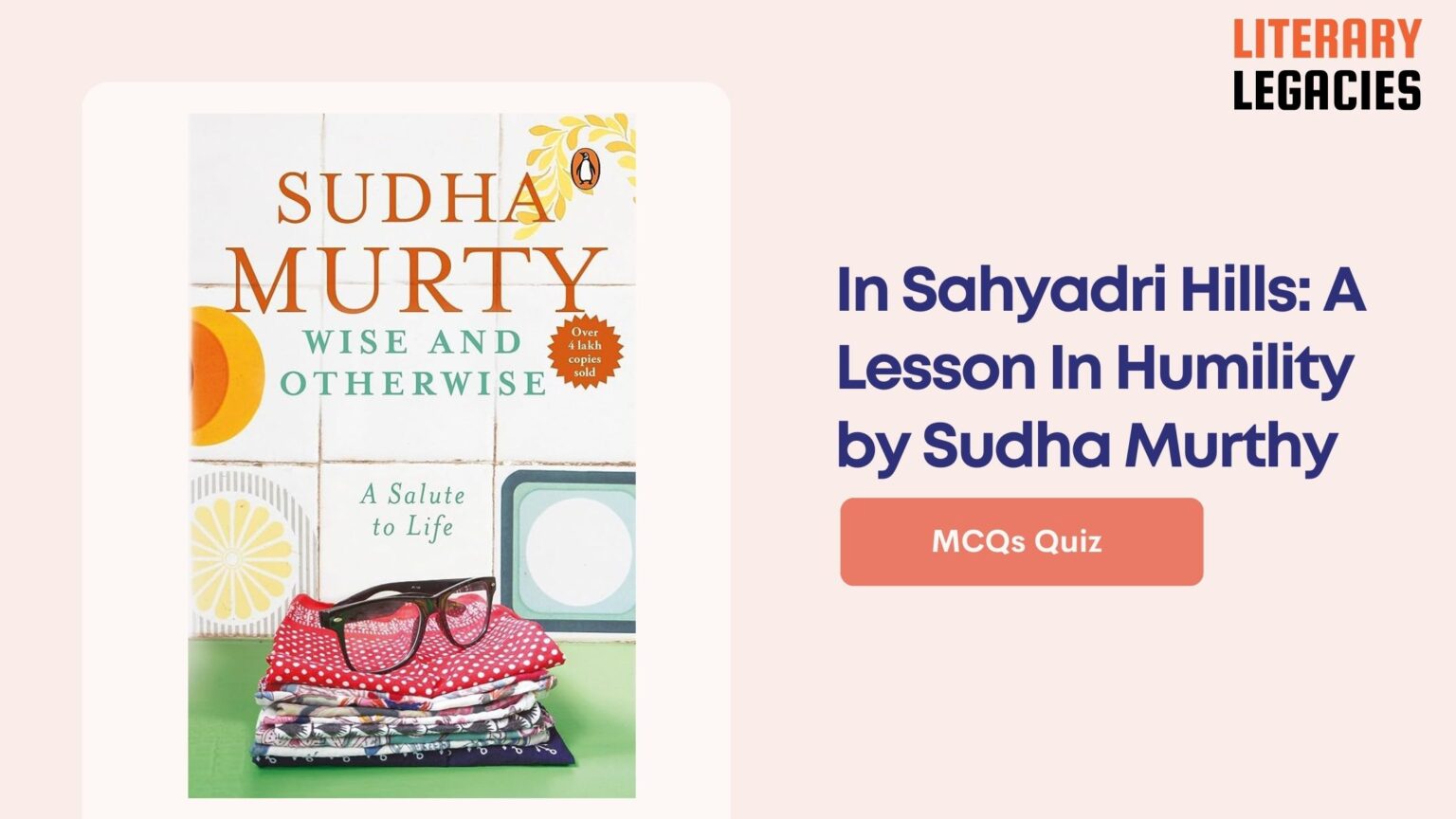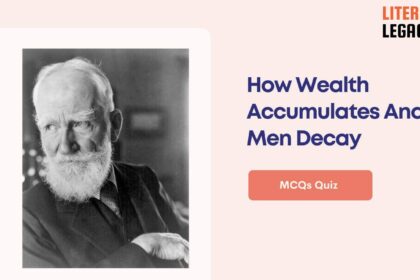1. What was Sudha Murthy’s initial intention when she visited the rural school?
A. To refuse the tribe’s gifts
B. To give gifts to the children
C. To teach the children about computers
D. To learn about the tribe’s culture
Answer: To give gifts to the children (B)
Sudha Murthy had brought clothes and umbrellas for the children.
2. What did the children express their wish to learn?
A. English
B. Mathematics
C. Science
D. Computers
Answer: Computers (D)
The children were interested in learning about computers.
3. What did Sudha Murthy promise to do if she couldn’t find computer books in Kannada?
A. Write a book on computers herself
B. Buy more gifts for the children
C. Visit the tribe again
D. Refuse to help the children
Answer: Write a book on computers herself (A)
Sudha Murthy was willing to write a book on computers if she couldn’t find one.
4. Why did Thandappa refuse to accept Sudha Murthy’s gifts?
A. Because he didn’t like the gifts
B. Because he was angry with Sudha Murthy
C. Because he was following a principle set by his ancestors
D. Because he wanted more gifts
Answer: Because he was following a principle set by his ancestors (C)
Thandappa followed a principle set by his ancestors.
5. What did Thandappa give to Sudha Murthy?
A. A book on computers
B. A basket of fruits
C. A traditional dress
D. A bottle of juice made from a red fruit
Answer: A bottle of juice made from a red fruit (D)
Thandappa gave Sudha Murthy a bottle of juice.
6. Why was Sudha Murthy hesitant to accept the juice from Thandappa?
A. Because she didn’t like the taste
B. Because she was allergic to the fruit
C. Because she didn’t want to offend Thandappa
D. Because she had gone there to give, not accept
Answer: Because she had gone there to give, not accept (D)
Sudha Murthy was hesitant to accept because she had gone to give, not accept.
7. What did Sudha Murthy feel after her encounter with Thandappa?
A. Angry
B. Disappointed
C. Confused
D. Impressed and humbled
Answer: Impressed and humbled (D)
Sudha Murthy was impressed and humbled by Thandappa’s principles.
8. What was the condition for accepting gifts according to Thandappa’s ancestors’ principle?
A. Only accept gifts when they have something to offer in return
B. Only accept gifts from people of the same tribe
C. Only accept gifts from strangers
D. Only accept gifts on special occasions
Answer: Only accept gifts when they have something to offer in return (A)
The principle was to only accept gifts when they have something to offer in return.
9. What did the children ask for in Kannada?
A. Books on English literature
B. Books on science
C. Books on mathematics
D. Books on computers
Answer: Books on computers (D)
The children asked for books on computers in Kannada.
10. What did Thandappa do when Sudha Murthy refused to accept his gift?
A. He forced her to take the gift
B. He apologized to her
C. He refused to talk to her
D. He also refused to accept her gifts
Answer: He also refused to accept her gifts (D)
Thandappa refused to accept Sudha Murthy’s gifts.
11. What was Sudha Murthy’s initial attempt to do for the children in the rural school?
A. Provide them with books in Kannada
B. Build a new school building
C. Distribute clothes and umbrellas
D. Teach them computer skills
Answer: Distribute clothes and umbrellas (C)
Sudha Murthy’s initial attempt was to provide some basic necessities to the children.
12. Why did Sudha Murthy visit the rural school?
A. To conduct a survey about the living conditions
B. To help the children with their education
C. To learn about the tribal culture
D. To promote her books among the tribals
Answer: To help the children with their education (B)
Sudha Murthy’s primary intention was to help the children with their education.
13. What can be inferred about the tribe’s values?
A. They are not interested in modern education
B. They prioritize dignity and self-respect
C. They are unwilling to accept help from outsiders
D. They value material possessions over relationships
Answer: They prioritize dignity and self-respect (B)
The tribe’s values are centered around dignity and self-respect, as reflected in Thandappa’s actions.
14. What was the significance of Thandappa’s gift to Sudha Murthy?
A. It was an attempt to bribe her
B. It was a way to show off his wealth
C. It was a gesture of friendship and respect
D. It was a token of appreciation for her gifts
Answer: It was a gesture of friendship and respect (C)
Thandappa’s gift to Sudha Murthy was a gesture of friendship and respect.
15. What lesson did Sudha Murthy likely learn from her encounter with Thandappa?
A. The value of humility and self-respect
B. The need to respect cultural differences
C. The importance of material wealth
D. The futility of helping rural communities
Answer: The value of humility and self-respect (A)
Sudha Murthy likely learned the value of humility and self-respect from her encounter with Thandappa.
16. What was the purpose of Sudha Murthy’s visit to the hilly area?
A. To learn about the tribal culture
B. To conduct a survey on the living conditions of the tribe
C. To distribute umbrellas and clothes to rural school children
D. To teach the children about computers
Answer: To distribute umbrellas and clothes to rural school children (C)
Sudha Murthy had a specific purpose for visiting the rural school in the hilly area.
17. What was unique about the gift given by Sudha Murthy to the children?
A. It was something they had asked for
B. It was a handmade item
C. It was a gift in exchange for something they had given her
D. It was a rare and expensive gift
Answer: It was something they had asked for (A)
Sudha Murthy’s gifts to the children were in response to their specific request.
18. What did Sudha Murthy learn from her encounter with Thandappa?
A. The value of humility and reciprocity
B. The significance of age and authority
C. The importance of material gifts
D. The power of formal education
Answer: The value of humility and reciprocity (A)
Sudha Murthy was impressed and humbled by Thandappa’s high principles.
19. Why did Thandappa decline Sudha Murthy’s gifts?
A. Because he didn’t know what to do with them
B. Because his ancestors had taught him to only accept gifts with reciprocity
C. Because he wanted to show his gratitude
D. Because he didn’t like the gifts
Answer: Because his ancestors had taught him to only accept gifts with reciprocity (B)
Thandappa’s reason for declining Sudha Murthy’s gifts was rooted in his ancestral values.
20. What was the children’s reaction when Sudha Murthy promised to get them computer books in Kannada?
A. They were confused and didn’t understand
B. They were disappointed and unhappy
C. They were happy beyond words
D. They were skeptical and unsure
Answer: They were happy beyond words (C)
The children were overjoyed when Sudha Murthy promised to get them computer books in Kannada.
21. What did Sudha Murthy refuse to accept from Thandappa?
A. A gift of umbrellas
B. A gift of clothes
C. A book on computers
D. A bottle of juice made with a red fruit
Answer: A bottle of juice made with a red fruit (D)
Sudha Murthy refused to accept a specific gift from Thandappa due to certain reasons.
22. What was the significance of the juice made with a red fruit?
A. It was a rare and exotic fruit
B. It was a symbol of Thandappa’s appreciation
C. It was a gift that required reciprocity
D. It was a traditional drink of the tribe
Answer: It was a gift that required reciprocity (C)
The juice made with a red fruit held a specific significance in the context of Sudha Murthy’s encounter with Thandappa.
23. What did Sudha Murthy take with her to the rural school?
A. Only clothing
B. Clothing and umbrellas
C. Kannada-language books on computers
D. Only umbrellas
Answer: Clothing and umbrellas (B)
Sudha Murthy had brought some gifts for the students at the rural school.
24. What was the tribe’s senior member’s name?
A. Sudha Murthy
B. The Elderly Tribal Guy
C. Thandappa
D. The Forefather
Answer: Thandappa (C)
Thandappa was the tribe’s most senior member.
25. Why did Sudha Murthy initially refuse to accept the red fruit juice?
A. Because it was forbidden by the tribe
B. Because she had come to give, not to receive
C. Because she was allergic to red fruit
D. Because she didn’t like the taste
Answer: Because she had come to give, not to receive (B)
Sudha Murthy hesitated to take the juice because she had gone there to give and not accept.
26. What did Sudha Murthy learn about the tribe’s values?
A. They expect something in return for their gifts
B. They prioritize receiving over giving
C. They don’t accept gifts from outsiders
D. They are not interested in learning computers
Answer: They expect something in return for their gifts (A)
Thandappa refused to accept Sudha Murthy’s gifts because they could only receive gifts if they had something to contribute in return.
27. What was Sudha Murthy’s impression of Thandappa?
A. She was astonished and humbled by his high standards
B. She was intimidated by his authority
C. She thought he was uneducated and primitive
D. She saw him as a rival in helping the tribe
Answer: She was astonished and humbled by his high standards (A)
Sudha Murthy was astonished and humbled by the great standards upheld by Thandappa.
28. What was the context in which Sudha Murthy mentioned writing a book?
A. When she was teaching the children computers
B. When she was discussing her past experiences with Thandappa
C. When she couldn’t find Kannada-language books on computers
D. When she was distributing gifts to the children
Answer: When she couldn’t find Kannada-language books on computers (C)
Sudha Murthy promised to write a Kannada-language book on computers if she couldn’t find one.
29. What can be inferred about the tribe’s way of life?
A. They are nomadic and keep moving from place to place
B. They are very wealthy and resourceful
C. They have access to all modern amenities
D. They have limited resources and struggle to make ends meet
Answer: They have limited resources and struggle to make ends meet (D)
The natives themselves had little to eat and drink, indicating that they have limited resources.



